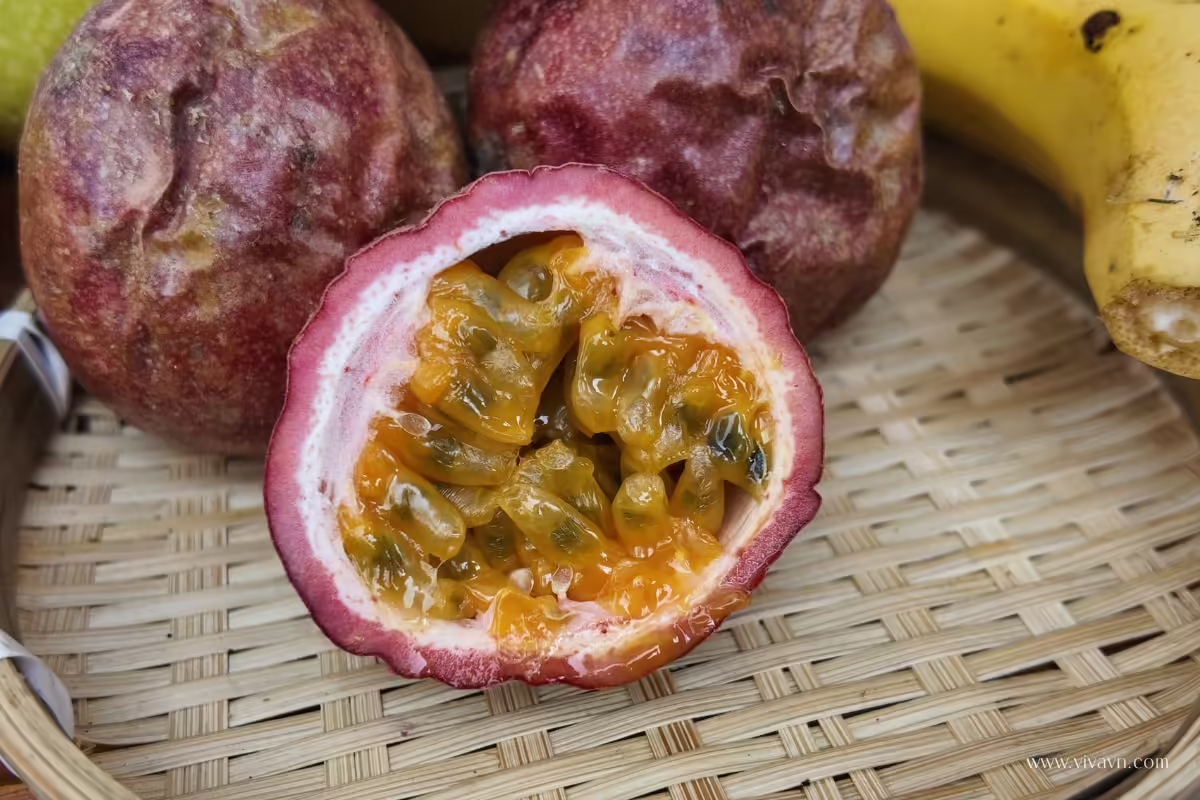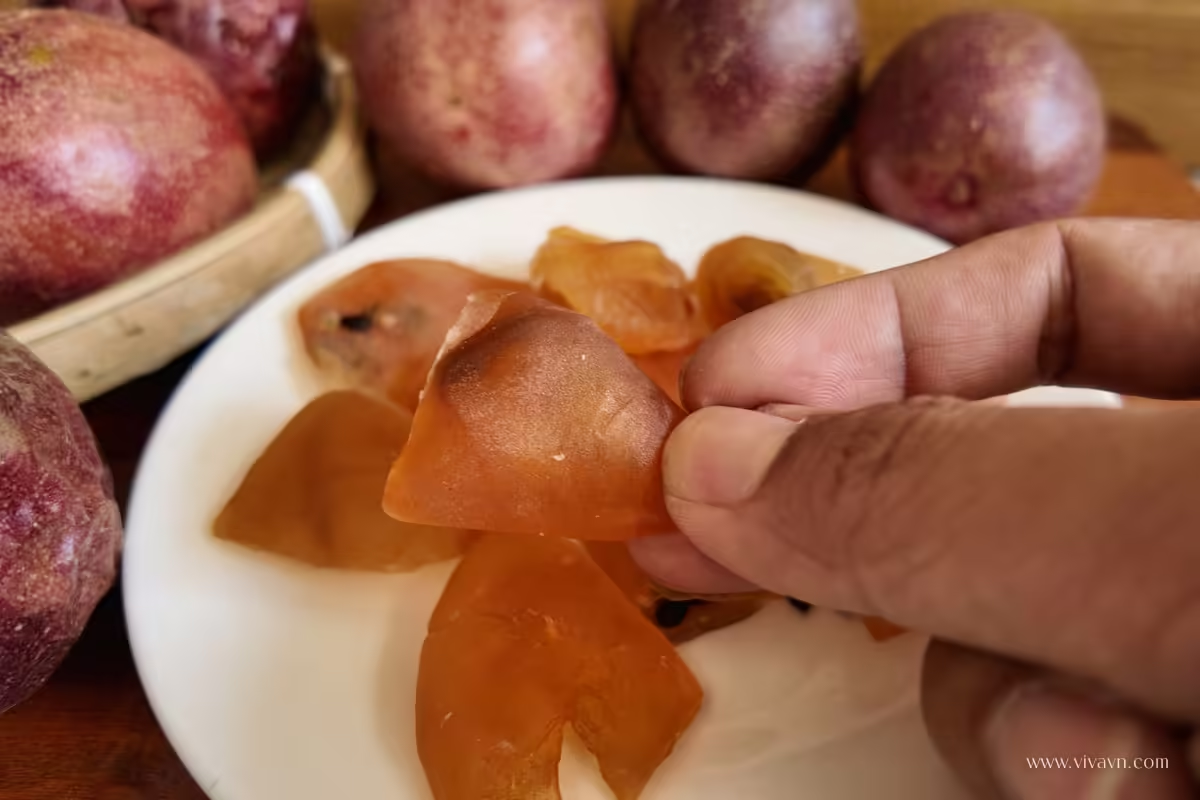
Vietnamese Passion Fruit: All You Need to Know About This Fruit
Vietnamese passion fruit may look a bit unusual at first glance—with its round, purple skin and slightly wrinkled surface—but inside, you’ll find a golden pulp with a tangy-sweet flavor and refreshing tropical aroma. In this article, we’ll take a closer look at both the outside and inside of this unique fruit, explore how it tastes, walk through its key ripening stages, and share a few easy, delicious ways to enjoy it.
What is Vietnamese passion fruit?
How to eat Vietnamese passion fruit
Popular ways to enjoy it
Frequently asked questions
What is Vietnamese passion fruit?
Overview
Vietnamese name: chanh day/ chanh leo
Shape and appearance: round or oval; smooth purple skin when ripe, sometimes with natural white specks.
Flavor profile: tart and citrusy with a hint of sweetness; aromatic and refreshing.
How to enjoy it: in Vietnam, passion fruit is enjoyed fresh, as juice, in desserts, or made into soft-dried fruit snacks.
What does a Vietnamese passion fruit look like?
Vietnamese passion fruit can be either round or oval in shape, and its appearance might surprise you if you’ve never seen one before. Most varieties grown in Vietnam have deep purple skin when ripe, sometimes with natural white specks on the surface — that’s completely normal.
Typically, the fruits measure around 4 to 8 centimeters (about 1.5 to 3.1 inches) in diameter. When freshly ripe, the skin is smooth and glossy. As the fruit becomes sweeter and more aromatic, the skin begins to wrinkle, which is actually a good sign.

Green Vietnamese passion fruits in their early ripening stage, hanging on the vine and not yet ready to eat.

Glossy purple passion fruit ripening on the vine in a Vietnamese garden.

Typical size of ripe Vietnamese passion fruit — about 5 cm in diameter.

From left to right: unripe green passion fruit, ripe purple fruit with smooth skin, and fully ripe fruit with wrinkled skin.
Take a look at the photo above to see the three common stages of ripeness:
Unripe: Green skin with white specks. The fruit is still firm and not ready to eat—pulp inside is too sour and underdeveloped.
Ripe: Smooth purple skin. This is the standard ripe stage, and the fruit is ready to eat with a sweet-tart flavor that’s refreshing and balanced.
Fully ripe: Wrinkled purple skin with softer pulp inside. At this stage, the flavor is sweeter, more aromatic, and less tangy—many people actually prefer eating passion fruit when it looks a little wrinkled like this.
Tip: For eating fresh, pick a passion fruit that feels heavy for its size and has slightly wrinkled skin—it’s usually sweeter and more flavorful.

Harvesting a ripe Vietnamese passion fruit by hand
What’s inside a Vietnamese passion fruit?
When you cut open a Vietnamese passion fruit, you’ll find three distinct layers. The thick outer skin is firm and often a deep purple color when ripe. Just beneath the skin is a soft, spongy white layer called the pith. While it’s not typically eaten, this layer helps protect the fruit’s flavorful center.
At the core is the golden pulp — a juicy, jelly-like filling packed with edible black seeds. This pulp is where all the flavor lives: sweet, tart, aromatic, and tropical. The seeds add a crunchy texture and are safe (and common) to eat along with the pulp.

A look inside a Vietnamese passion fruit showing the thick skin, white pith, and golden pulp with edible seeds.
What does Vietnamese passion fruit taste like?
Vietnamese passion fruit has a bright, tropical flavor with a mix of tartness and subtle sweetness. When freshly cut, the first thing you’ll notice is its signature tang — a sharp, citrusy sourness that’s refreshing rather than overpowering.
As the fruit ripens, a natural sweetness begins to emerge, softening the acidity and creating a more rounded, balanced flavor.

Golden pulp and black seeds of a ripe Vietnamese passion fruit — bold, tangy, and tropical.
Tip: Wrinkled skin usually means the passion fruit is ripe, fragrant, and sweeter — many Vietnamese people prefer it this way.
Just avoid any fruit with mold, or a sour smell — that’s a sign it’s gone bad.
How to eat Vietnamese passion fruit
Vietnamese passion fruit is easy to enjoy, whether you’re eating it fresh or adding it to your favorite recipes. Here’s a simple step-by-step guide to help you get the most out of this tropical fruit, complete with real photos.
Step 1: Wash the fruit
Before cutting, rinse the passion fruit under cool water to remove any dirt or debris. The outer skin isn’t eaten, but keeping things clean is always a good start.

Step 2: Slice it in half
Use a sharp knife to slice it in half. The outer skin is thick but cuts easily with a bit of pressure.

Step 3: Reveal the golden pulp
Once cut open, you’ll see the bright yellow-orange pulp filled with small black seeds. This is the edible part of the fruit — juicy, aromatic, and full of flavor.

Step 4: Scoop out the pulp
Grab a spoon and scoop the pulp straight from the shell. You can eat it fresh or use it to make drinks and desserts.

Step 5: Serve or store
Scoop the pulp into a glass cup if you’re using it in smoothies or drinks. You can enjoy it right away or refrigerate it for later use.

Popular ways to enjoy Vietnamese passion fruit
Passion fruit juice
In Vietnam, passion fruit juice is a simple, well-loved drink, especially during the hot summer months. It’s easy to make and packed with natural flavor.
To prepare it, you just cut open a ripe passion fruit, scoop the pulp into a glass, add some cool water, and stir in a bit of sugar or honey to taste. Toss in a handful of ice cubes, and that’s it — you’ve got a refreshing, tangy-sweet drink that’s both hydrating and full of tropical aroma.

Vietnamese passion fruit juice with honey and ice
Soft-dried Vietnamese passion fruit
Ripe passion fruit is slowly dried to reduce its sourness and bring out a mellow sweetness. Its natural aroma and flavor are preserved, resulting in a chewy snack with a bright, balanced taste.
Soft-dried passion fruit is a popular Vietnamese treat — slightly sweet, tangy, and full of tropical flavor. It’s a great option for anyone who enjoys natural fruit snacks and one of the most distinctive choices among Vietnamese dried fruits.

A slice of soft-dried Vietnamese passion fruit showing its chewy texture and brown color
Want to try it yourself?
Here’s a soft-dried passion fruit snack available on Amazon — a lovely option if you’d like to experience how it’s enjoyed in Vietnam. (This is an affiliate link, which means I may earn a small commission if you make a purchase — at no additional cost to you.)
Fresh passion fruit with honey
Another easy way to enjoy Vietnamese passion fruit is to eat it straight from the shell, with a little honey added right inside. Just cut the fruit in half, drizzle a spoonful of honey over the pulp, and scoop it out with a spoon. You can also scoop the pulp into a glass, stir in honey to taste, and enjoy it that way.
This method brings out a softer sweetness while keeping the fruit’s bright, tropical flavor. No prep needed — just fresh, simple, and satisfying.

A little honey turns this Vietnamese passion fruit into a sweet, spoon-ready treat.
Frequently asked questions about Vietnamese passion fruit
What does Vietnamese passion fruit taste like?
The taste is bright, tangy, and tropical, with a citrus-like tartness that becomes softer and sweeter as the fruit ripens. When combined with honey or sugar, it transforms into a balanced, refreshing treat.
How do you know when Vietnamese passion fruit is ripe?
A ripe Vietnamese passion fruit will have deep purple skin that’s either smooth or slightly wrinkled. The more wrinkled it is, the sweeter and more aromatic the pulp tends to be.
Can you eat Vietnamese passion fruit seeds?
Yes, the black seeds inside the pulp are generally considered edible. Some people eat them along with the juicy pulp, as they add a bit of texture. Others prefer to strain the seeds out and use just the liquid and pulp. If you have any concerns or digestive sensitivities, it’s a good idea to check with your doctor first.
Share on FacebookShare on TwitterShare on PinterestShare on WhatsappShare on LinkedinShare on TelegramShare on Email
- https://www.youtube.com/@VivaVNOfficial
- https://www.facebook.com/vivavnofficial2024
- https://www.pinterest.com/vivavnofficial/
© 2025 VivaVN. All rights reserved.


Leave a Reply